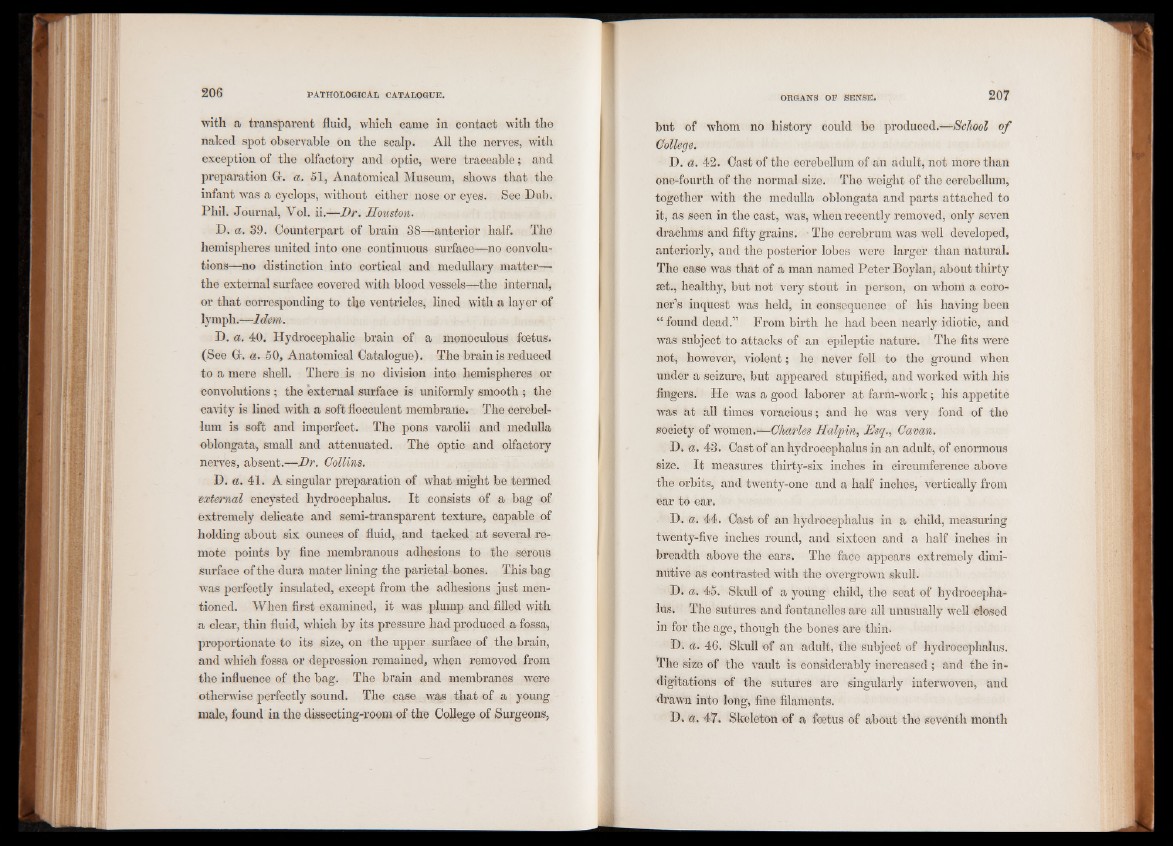
with a transparent fluid, which came in contact with the
naked spot observable on the scalp. All the nerves, with
exception of the olfactory and optic, were traceable; and
preparation Gr. a. 51, Anatomical Museum, shows that the
infant was a cyclops, without either nose or eyes. See Dub.
Phil. Journal, Vol. ii —Dr. Houston.
D. a. 39. Counterpart of brain 38—anterior half. The
hemispheres united into one continuous surface—no convolutions—
no distinction into cortical and medullary matter—
the external surface covered with blood vessels—the internal,
or that corresponding to the ventricles, lined with a layer of
lymph.—Idem.
D. a. 40. Hydrocephalic brain of a monoculous foetus.
(See Gr, a. 50, Anatomical Catalogue). The brain is reduced
to a mere shell. There. is no division into hemispheres or
convolutions ; the external surface is uniformly smooth ; the
cavity is lined with a soft flocculent membrane. The cerebellum
is soft and imperfect. The pons varolii and medulla
oblongata, small and attenuated. The optic and olfactory
nerves, absent.—Dr. Collins.
D. a. 41. A singular preparation of what might be termed
external encysted hydrocephalus. It consists of a bag of
extremely delicate and semi-transparent texture, capable of
holding about six ounces of fluid, and tacked at several remote
points by fine membranous adhesions to the serous
surface of the dura mater lining the parietal bones. This bag
was perfectly insulated, except from the adhesions just mentioned.
When first examined, it was plump and filled with
a clear, thin fluid, which by its pressure had produced a fossa,
proportionate to its size, on the upper surface of the brain,
and which fossa or depression remained, when removed from
the influence of the bag. The brain and membranes were
otherwise perfectly sound. The case was that of a young
male, found in the dissecting-room of the College of Surgeons,
but of whom no history could be produced.—School of
College.
D. a. 42. Cast of the cerebellum of an adult, not more than
one-fourth of the normal size. The weight of the cerebellum,
together with the medulla oblongata and parts attached to
it, as seen in the cast, was, when recently removed, only seven
drachms and fifty grains. • The cerebrum was well developed,
anteriorly, and the posterior lobes were larger than natural.
The case was that of a man named Peter Boylan, about thirty
æt., healthy, but not very stout in person, on whom a coronet’s
inquest was held, in consequence of his having been
“ found dead.” From birth he had been nearly idiotic, and
was subject to attacks of an epileptic nature. The fits were
not, however, violent ; he never fell to the ground when
under a seizure, but appeared stupified, and worked with his
fingers, He was a good laborer at farm-work ; his appetite
was at all times voracious; and he was very fond of the
society of women.—Charles Halpin, Esq., Cavan.
D. a. 43. Cast of an hydrocephalus in an adult, of enormous
size. It measures thirty-six inches in circumference above
the orbits, and twenty-one and a half inches, vertically from
ear to ear.
D. a. 44. Cast of an hydrocephalus in a child, measuring
twenty-five inches round, and sixteen and a half inches in
breadth above the ears. The face appears extremely diminutive
as contrasted with the overgrown skull.
D. a. 45. Skull of a young child, the seat of hydrocepha-
lusi The sutures and fontanelles are all unusually well closed
in for the age, though the bones are thin,
D. a. 46. Skull of an adult, the subject of hydrocephalus.
The size of the vault is considerably increased ; and the in-
digitations of the sutures are singularly interwoven, and
drawn into long, fine filaments.
D» a. 47. Skeleton of a foetus of about the seventh month